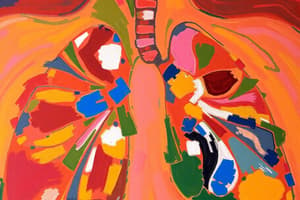Podcast
Questions and Answers
Which factor least contributes to the manifestation of Respiratory Distress Syndrome (RDS) in preterm infants?
Which factor least contributes to the manifestation of Respiratory Distress Syndrome (RDS) in preterm infants?
- Deficient surfactant production leading to alveolar collapse.
- Functional immaturity of the lungs affecting gas exchange efficiency.
- Highly compliant chest wall due to a predominance of cartilage.
- Accelerated maturation of type II alveolar cells before 36 weeks gestation. (correct)
A preterm infant with RDS is experiencing increased pulmonary vascular resistance (PVR). How does this physiological change affect the neonate's circulation?
A preterm infant with RDS is experiencing increased pulmonary vascular resistance (PVR). How does this physiological change affect the neonate's circulation?
- It causes a partial reversion to fetal circulation with right-to-left shunting. (correct)
- It promotes closure of the ductus arteriosus and foramen ovale.
- It dilates pulmonary arterioles, decreasing blood pressure.
- It enhances pulmonary blood flow, improving oxygenation.
A neonate with RDS is undergoing anaerobic glycolysis due to prolonged hypoxemia. Which acid-base imbalance is most likely to develop as a direct consequence of this metabolic shift?
A neonate with RDS is undergoing anaerobic glycolysis due to prolonged hypoxemia. Which acid-base imbalance is most likely to develop as a direct consequence of this metabolic shift?
- Respiratory alkalosis due to hyperventilation.
- Metabolic alkalosis due to excessive bicarbonate production.
- Respiratory acidosis due to carbon dioxide retention.
- Metabolic acidosis due to increased lactic acid production. (correct)
In managing a preterm infant with RDS, what is the rationale behind avoiding nipple and gavage feedings when the respiratory rate is markedly increased?
In managing a preterm infant with RDS, what is the rationale behind avoiding nipple and gavage feedings when the respiratory rate is markedly increased?
What is the primary rationale for administering exogenous surfactant to preterm neonates with RDS?
What is the primary rationale for administering exogenous surfactant to preterm neonates with RDS?
A preterm infant with RDS is receiving mechanical ventilation. Which adjustment to ventilator settings would directly increase the mean airway pressure (MAP)?
A preterm infant with RDS is receiving mechanical ventilation. Which adjustment to ventilator settings would directly increase the mean airway pressure (MAP)?
A neonate with meconium aspiration syndrome (MAS) is exhibiting signs of persistent pulmonary hypertension of the newborn (PPHN). What is the underlying mechanism linking MAS to the development of PPHN?
A neonate with meconium aspiration syndrome (MAS) is exhibiting signs of persistent pulmonary hypertension of the newborn (PPHN). What is the underlying mechanism linking MAS to the development of PPHN?
A preterm infant is experiencing frequent apneic episodes. Which nursing intervention is most appropriate when the cardiorespiratory monitor alarm indicates cessation of breathing?
A preterm infant is experiencing frequent apneic episodes. Which nursing intervention is most appropriate when the cardiorespiratory monitor alarm indicates cessation of breathing?
A term newborn is diagnosed with hyperbilirubinemia. How does early and frequent breastfeeding influence serum bilirubin levels?
A term newborn is diagnosed with hyperbilirubinemia. How does early and frequent breastfeeding influence serum bilirubin levels?
Which of the following statements best explains the mechanism of action of phototherapy in the treatment of hyperbilirubinemia?
Which of the following statements best explains the mechanism of action of phototherapy in the treatment of hyperbilirubinemia?
Flashcards
Respiratory Distress Syndrome (RDS)
Respiratory Distress Syndrome (RDS)
Condition of surfactant deficiency and physiologic immaturity of the thorax, primarily in preterm infants.
Surfactant
Surfactant
Surface-active phospholipid that reduces surface tension in the alveoli, promoting uniform lung expansion.
Atelectasis in RDS
Atelectasis in RDS
Unequal inflation of alveoli leading to collapse at the end of expiration due to deficient surfactant.
Pulmonary Interstitial Emphysema (PIE)
Pulmonary Interstitial Emphysema (PIE)
Signup and view all the flashcards
Persistent Pulmonary Hypertension of the Newborn (PPHN)
Persistent Pulmonary Hypertension of the Newborn (PPHN)
Signup and view all the flashcards
Suctioning the Newborn
Suctioning the Newborn
Signup and view all the flashcards
Apnea of Prematurity (AOP)
Apnea of Prematurity (AOP)
Signup and view all the flashcards
Therapeutic Management of RDS (Respiratory Distress Syndrome)
Therapeutic Management of RDS (Respiratory Distress Syndrome)
Signup and view all the flashcards
Sudden Infant Death Syndrome (SIDS)
Sudden Infant Death Syndrome (SIDS)
Signup and view all the flashcards
Neonatal Sepsis
Neonatal Sepsis
Signup and view all the flashcards
Study Notes
Respiratory Distress Syndrome (RDS)
- RDS is due to surfactant deficiency and physiologic immaturity of the thorax
- Respiratory distress syndrome and hyaline membrane disease often relate to severe lunch disorders
- Almost exclusively impacts preterm infants
- Associated conditions include multifetal pregnancies, infants of diabetic mothers, cesarean section delivery, cold stress, asphyxia, and family history of RDS (Warren and Anderson, 2010)
- Rarely observed in drug exposed infants or infants that experience chronic intrauterine stress, such as maternal preeclampsia or hypertension
- Nonpulmonary respiratory distress can be a result of sepsis, cardiac defects (structural or functional), exposure to cold, airway obstruction (atresia), IVH, hypoglycemia, metabolic acidosis, acute blood loss, and drugs
- Pneumonia in the neonatal period causes respiratory distress and can co-occur with RDS
Pathophysiology
- Preterm infants lungs aren't ready for gas exchange
- RDS results from structural and functional immaturity
- Alveolar septa unfold during the last trimester, preterm infants have many non inflatable alveoli
- Fetal chest wall is highly compliant due to more cartilage than bone
- The diaphragm, the primary respiratory muscle, is prone to fatigue
- Fetal lungs are deficient in surfactant, a surface-active phospholipid secreted by type II cells in the alveolar epithelium
- Surfactant is first produced at ~24 weeks gestational age, but type II cells don’t mature until ~36 weeks
- Surfactant acts much like a detergent and reduces the surface tension of fluids that line the alveoli and and results in uniform expansion and maintenance
- Immature development compromises respiratory efficiency
- Deficient surfactant yields unequal inflation of alveoli on inspiration and the collapse of alveoli on end expiration
- Infants exert effort to re-expand alveoli and can require much negative pressure (60 to 75 cm H2O) for initial lung expansion at birth
- Inability to maintain lung expansion produces widespread atelectasis
- In the absence of alveolar stability and with progressive atelectasis, pulmonary vascular resistance (PVR) increases
- Normal lung expansion decreases PVR
- Leads to hypoperfusion to the lung tissue, with a decreased effective pulmonary blood flow
- Increased PVR causes partial reversion to the fetal circulation, with a right-to-left shunting of blood through the persisting fetal communications-the ductus arteriosus and foramen ovale
- Inadequate pulmonary perfusion and ventilation produces hypoxemia and hypercapnia
- Decreased oxygen tension causes vasospasm in the pulmonary arterioles that is worsened by a decrease in blood pH, contributing to a marked increase in PVR
- In normal ventilation with increased oxygen concentration, the ductus arteriosus constricts and the pulmonary vessels dilate to decrease PVR
- Prolonged hypoxemia activates anaerobic glycolysis, yielding increased amounts of lactic acid, causing metabolic acidosis
- Inability of the atelectatic lungs to blow off excess carbon dioxide produces respiratory acidosis
- Lowered pH potentiates vasoconstriction
- With deficient pulmonary circulation and alveolar perfusion, PaO2 continues to fall, pH falls, and materials needed for surfactant production are not circulated to the alveoli
- Pulmonary edema also contributes to impaired gas exchange
- Factors believed to facilitate fluid accumulation include renal immaturity or insufficiency resulting from hypoxemia, high fluid intake and PDA, left ventricular dysfunction associated with papillary muscle necrosis, low serum protein concentration and low colloid osmotic pressure, increased alveolar surface tension that enhances the shift of interstitial fluid to alveolar spaces, oxygen toxicity, and high plasma vasopressin
- Pulmonary interstitial emphysema (PIE) may develop in preterm infants with RDS and immature lungs by overdistention of distal airways
Clinical Manifestations
- Develop respiratory distress either acutely or over a period of hours, by pulmonary immaturity, associated illness factors, and gestational maturity
- Signs usually occur for infants with normal Color and breathing soon after birth
- Breathing becomes rapid (>60 breaths/min)
- Retractions occur which result from a compliant chest wall
- Weak chest wall muscles and cartilaginous rib structure produce an abnormally elastic rib cage, resulting in indrawing, or retraction, of the skin between the ribs.
- Infant’s color may remain good, and auscultation reveals air entry
- Other signs can be tachypnea grunting and retractions
- Central cyanosis is a late and serious sign
- Pulse oximetry and arterial blood gas sampling used to determine oxygen requirements
- Severe RDS relates to diminish cardiac inflow and low arterial blood pressure
- Due to extreme pulmonary immaturity, the ELBW and VLBW infant may have severe RDS at birth, bypassing the aforementioned steps in development
- Infants with RDS may receive the surfactant
- Associated complications (of prematurity and RDS) include PDA and congestive heart failure, retinopathy of prematurity, IVH, BPD, NEC, and neurologic sequelae
Diagnostic Evaluation
- Lab data is nonspecific and the abnormalities are identical to observed in numerous biochemical abnormalities of the newborn
- Specific tests determine complicating factors, such as blood glucose, blood gas measurements for serum pH and PaO2
- Important component is pulse oximetry
- Radiographic findings include diffuse granular pattern over both lung fields resembling ground glass representing alveolar atelectasis, and dark streaks or air bronchograms, within the ground glass areas representing dilated, air-filled bronchioles
- RDS and pneumonia must be differentiated.
Therapeutic Management
- Treat RDS with general measures required for any preterm infant, as well as those instituted to correct imbalances
- Crucial supportive measures:
- Maintain adequate ventilation and oxygenation via :
- continuous positive airway pressure (CPAP)
- high-flow nasal cannula
- mechanical ventilation
- Maintain acid-base balance
- Maintain a neutral thermal environment
- Maintain adequate tissue perfusion and oxygenation
- Prevent hypotension
- Maintain adequate hydration and electrolyte status.
- Maintain adequate ventilation and oxygenation via :
- Nipple and gavage feedings avoided to prevent aspiration
Surfactant
- Many neonatal centers globally use administering exogenous surfactant
- Clinical trials of the exogenous surfactant demonstrate improvements in blood gas values and ventilator settings, decrease pulmonary leaks, decreased deaths from RDS, and a lower infant mortality rate
- Exogenous surfactant can come from a natural source or artificial surfactant
- Mixed results in comparing surfactant products
- Found fewer complications and earlier improvement using natural (versus synthetic) surfactant
- Benefits
- Decreased oxygen requirements and mean airway pressure (MAP) in hours
- Overall decrease in pulmonary air leaks
- Prophylactic surfactant, administered at birth, and early rescue, administered within 2 hours of birth, have both had success
Oxygen Therapy
- Prevent lactic acid, improve hypoxia, avoid toxic effects
- Warm all gas before entering respiratory tract
- Oxygen can be given via nasal prongs
- If saturation cannot be maintained will need assistance for ventilation
- Recommend range between 21% and 100% oxygen
- Oxygen delivery maintain Spo2 of 83% to 93% in preterm infants
- Maintaining the oxygen prevents conditions but this is not yet known
Studying That Suits You
Use AI to generate personalized quizzes and flashcards to suit your learning preferences.



